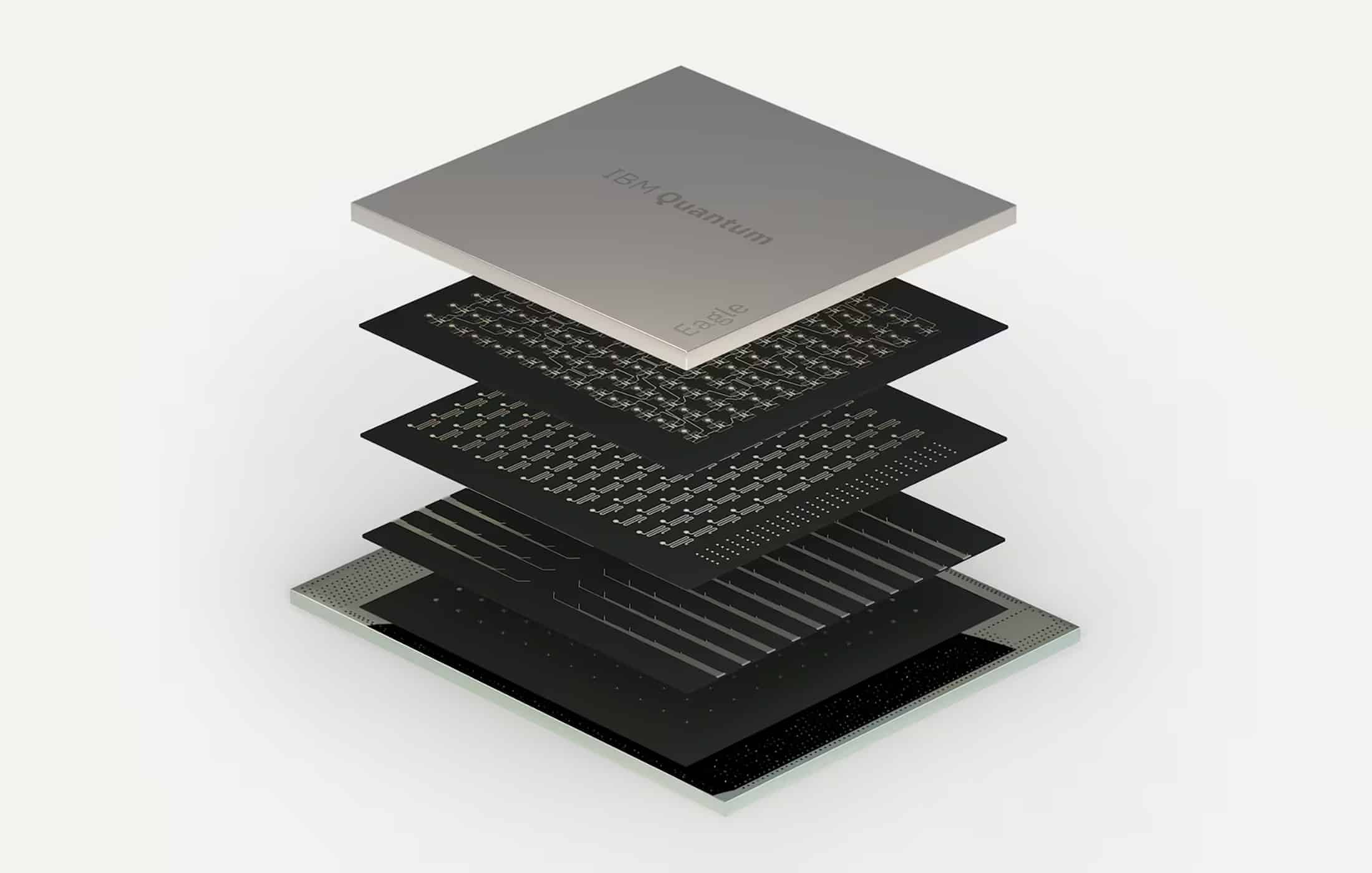IBM Eagle: The First 100+ Qubit Quantum Processor

Table of Contents
Yorktown Heights, N.Y., USA (Nov 2021) – IBM has announced Eagle, a 127-qubit superconducting quantum processor – the world’s first quantum chip to surpass 100 qubits. Unveiled at the IBM Quantum Summit in late 2021, Eagle marks a major milestone in quantum computing, nearly doubling the qubit count of IBM’s previous 65-qubit “Hummingbird” processor and overtaking the scale of rival devices like Google’s 53-qubit Sycamore. IBM’s researchers herald Eagle as ushering in a “new era” where quantum computers can explore computational problems beyond the reach of classical machines. By breaking the 100-qubit barrier, Eagle moves the industry one step closer to demonstrating quantum advantage – the point at which quantum computers outperform classical supercomputers on useful tasks – a goal IBM believes it can achieve within the next couple of years.
Pushing Quantum Computation Beyond Classical Limits
Eagle’s 127 qubits place it in a regime that is extraordinarily hard to simulate with any classical computer. In a classical sense, each additional qubit doubles the size of the quantum state space, so a 127-qubit system corresponds to $$2^{127}$$ complex amplitudes – roughly $$1.7\times10^{38}$$ values. Storing and processing that many parameters is well beyond the capacity of the world’s largest supercomputers, which makes Eagle effectively impossible to brute-force simulate using conventional methods. This is why IBM describes Eagle as its first “utility-scale” quantum processor, meaning it opens a window to explore calculations that were previously infeasible to model exactly on classical hardware. “As quantum processors scale up, each additional qubit doubles the amount of memory space required to reliably simulate quantum circuits [classically],” IBM noted in its announcement, underscoring the significance of reaching triple-digit qubit counts.
Crucially, Eagle’s record qubit count does not immediately equate to useful computational power – the quality of those qubits and their operations matters as much as the quantity. IBM is candid that there is “work yet to be done” on improving qubit fidelity and speed. The company uses metrics like Quantum Volume (which combines qubit count and error rates) and Circuit Layer Operations Per Second (CLOPS) (a speed benchmark) to track overall performance. In past generations, IBM steadily doubled quantum volume through better error rates and calibration, not just adding qubits. With Eagle, IBM signaled the need to continue pushing coherence times and gate fidelities alongside scaling up qubits. Notably, at the time of Eagle’s debut IBM had not yet disclosed its full performance metrics – officials told the press that they were still benchmarking its coherence and error rates and had no quantum volume number to announce immediately. In other words, Eagle’s launch was a triumph of engineering scale, while the task of fine-tuning its “high-quality” qubits was ongoing.
Eagle vs. Sycamore and Zuchongzhi: A Leap in Scale
IBM’s 127-qubit breakthrough comes on the heels of several high-profile, but smaller-scale, superconducting quantum efforts. Google’s Sycamore processor (with 53 qubits) made headlines in 2019 when it performed a random circuit sampling task in a few minutes that was estimated to take an impractical 10,000 years on a classical supercomputer. That experiment was trumpeted as the first empirical demonstration of quantum supremacy, showing a quantum device outpacing any known classical algorithm for a contrived problem. Similarly, in 2021 a team at China’s University of Science and Technology of China (USTC) demonstrated a 66-qubit superconducting chip named Zuchongzhi 2.1 performing random circuit sampling with 56 qubits at 20 cycles depth. They estimated that what Zuchongzhi accomplished in about 1.2 hours would have taken a state-of-the-art supercomputer at least 8 years to simulate. This achievement established China’s claim to quantum computational advantage in the superconducting domain, making China the first country to reach that landmark in two different quantum platforms (having already demonstrated photonic quantum advantage with the 113-photon Jiuzhang prototype in 2020).
Compared to Google’s and USTC’s quantum chips, IBM’s Eagle offers more than double the qubit count of those earlier devices. It leapfrogs USTC’s 66-qubit record and represents the largest universal gate-based quantum processor publicly disclosed as of 2021. However, it’s important to note that Google and USTC achieved their landmark results by running very specific benchmark tasks on chips with fewer qubits but relatively high fidelities. IBM, by contrast, did not rush to perform a “quantum supremacy” stunt with Eagle at launch. Instead, IBM’s strategy has emphasized building a general-purpose quantum computing platform and improving all-around performance metrics. Eagle’s debut was about pushing the hardware frontier (demonstrating that a 127-qubit device can be built and operated), while laying groundwork for tackling practical problems as the technology matures. “Breaking the 100-qubit barrier […] wasn’t something we could do overnight,” IBM’s Quantum team wrote, highlighting years of research in materials, fabrication and packaging that led to Eagle’s design.
IBM’s focus on a road map of steadily increasing qubit counts is clear. Alongside Eagle’s announcement, the company revealed plans for a 433-qubit processor called Osprey in 2022 and a 1,121-qubit chip called Condor targeted for 2023. If all goes according to plan, those devices would bring IBM close to the threshold of quantum advantage — the point where a quantum computer can outperform classical systems on meaningful, real-world tasks. “We believe that we will be able to reach a demonstration of quantum advantage – something that can have practical value – within the next couple of years. That is our quest,” said Dr. Darío Gil, IBM’s Director of Research, emphasizing that quantum processors will start to tackle useful problems even as they work in tandem with classical computers. In IBM’s vision, quantum chips like Eagle will eventually serve alongside classical CPUs and GPUs, each handling the parts of an application they run best.
Engineering Breakthroughs Under the Hood
Achieving 127 working qubits on a single chip required significant engineering innovations in Eagle’s design. Simply putting more qubits on a chip is not straightforward – control wiring, crosstalk, and fabrication yield issues grow dramatically as qubit counts rise. IBM’s previous 65-qubit chip used a basic two-layer architecture (a qubit chip bump-bonded to an interposer) that was reaching its limits for component density. Eagle introduces a new multi-tiered architecture that separates different functions of the quantum processor across multiple layers. IBM leveraged advanced 3D packaging techniques – expertise borrowed from modern classical processor manufacturing – to build a stack of chip layers within the quantum module. In Eagle, the qubits themselves reside on one layer (the “qubit plane”), while a separate layer above contains the readout resonators and another layer routes control wiring, all sandwiched together with high-density interconnects. By distributing components vertically, Eagle can provide “scalable access wiring to all qubits” without crowding the 2D chip surface. This 3D integration was “the key to squeezing all those qubits into one chip,” allowing control electronics and qubits to be placed on different levels of the stack.
Another critical innovation in Eagle is readout multiplexing – the ability to read multiple qubits using the same electronics. Earlier superconducting processors required a dedicated microwave control line and a separate readout resonator for each qubit, which becomes impractical beyond a few dozen qubits. Eagle instead uses frequency multiplexing so that several qubits share the same readout line at different frequencies. This drastically reduces the number of coaxial cables and control hardware channels coming into the cryogenic refrigerator, easing the bottleneck of physically wiring up 127 qubits. IBM had prototyped this technique in a revision of its prior chip (Hummingbird R2), and in Eagle it proved essential to scale past 100 qubits without an “explosion” of control wiring.
Perhaps the most talked-about feature of Eagle’s design is its “heavy-hex” qubit layout. IBM introduced the heavy-hexagonal lattice topology in its 2019–2020 devices (e.g. the 27-qubit Falcon chip) to improve performance and yield. In a heavy-hex layout, each qubit is connected to at most 2 or 3 neighbors in a pattern that looks like a tessellation of hexagons, rather than the square grid of nearest-neighbors used in Google’s Sycamore. The rationale is to reduce unwanted interactions and cross-talk between adjacent qubits by not packing them all next to each other. Fewer neighbors per qubit mean fewer opportunities for stray coupling and frequency collisions, which in turn can improve coherence and two-qubit gate fidelities. IBM reported that heavy-hex cut error rates enough to significantly boost the yield of functional qubits on their wafers. The trade-off is that each qubit has reduced connectivity – quantum circuits may need more steps to shuffle information around the chip. IBM appears to be betting that smart compiler software and error mitigation can overcome this trade-off, while the hardware benefits of heavy-hex (more stable qubits in greater numbers) are well worth it. Eagle’s use of the heavy-hex topology, combined with the 3D multilayer wiring and multiplexed readout, showcases how IBM is tackling the challenge of quantum scaling from multiple angles – qubit layout, control infrastructure, and fabrication all had to evolve to enable a 127-qubit processor.
Why Eagle Matters for the Future of Quantum Computing
Beyond the technical specs, Eagle’s debut carries broader implications for the quantum computing industry. It is a tangible proof-point that quantum hardware is progressing in line with (or even a bit ahead of) the aggressive roadmaps laid out by major players. Surpassing 100 qubits on a programmable superconducting processor was a long-awaited milestone, and it signals that the field has entered a new scaling regime. Indeed, IBM’s announcement came amid a flurry of quantum computing news in 2021: Google had set a goal of a useful quantum computer by 2029, startups were touting novel approaches (for instance, a day after Eagle’s reveal, a startup called QuEra unveiled a 256-qubit neutral-atom quantum simulator), and supercomputing experts were debating the meaning of “quantum supremacy” in practice. Eagle’s successful implementation bolsters IBM’s position in this global race and will likely spur competitors to accelerate their own development efforts.
For the quantum computing community, Eagle provides a new platform to experiment with algorithms that were previously out of reach. Early users (research partners and IBM’s own teams) can run larger and more complex circuits, testing how far error mitigation techniques can be pushed on a device of this scale. Already, studies have indicated that Eagle’s 127 qubits, combined with clever error-mitigation, can solve certain physics problems faster or more accurately than a classical supercomputer. These hints of quantum advantage in practical tasks – even without full error correction – are exciting, because they suggest useful quantum computation might emerge sooner than pessimists expect. In fields like quantum chemistry, materials science, and optimization, researchers are eager to explore the “uncharted computational territory” that Eagle opens up.
Meanwhile, Eagle’s achievement is also a reminder of how far there is to go. At 127 qubits, these processors are still in the noisy intermediate-scale quantum (NISQ) era – error rates are high, and none of today’s devices can implement the deep, large circuits needed for applications like Shor’s factoring algorithm. From a cybersecurity perspective, Eagle does not meaningfully threaten modern encryption algorithms; breaking RSA-2048 via Shor’s algorithm is estimated to require on the order of thousands of perfect logical qubits (which in turn would require many physical qubits per logical qubit for error correction). However, the rapid pace of progress underscored by Eagle is exactly why the security community is actively developing post-quantum cryptography – the writing is on the wall that far larger quantum machines will arrive in coming years. Eagle’s design innovations (like its modular control architecture) are directly aimed at enabling the next orders of magnitude growth in qubit count. If IBM’s 433-qubit and 1,000+ qubit targets are met on schedule in 2022–2023, the conversation will quickly shift from “can we build this?” to “what can we do with it?” – and also “how do we keep it stable?”



